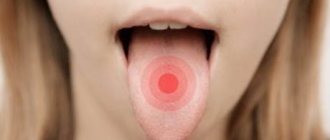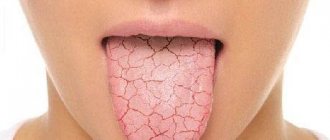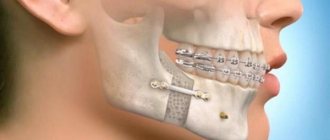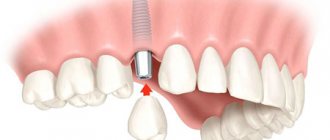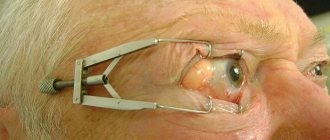The tongue is an organ that not only helps us enjoy food and conversations; its structure and functionality allow specialists to identify many diseases of patients. For example, problems with the heart and lungs are projected onto the area of the top of the tongue in the form of redness and cracks, the surface of its back allows us to judge diseases of the liver and spleen, the root of this organ tells about problems with the stomach, and the side areas about the condition of the kidneys. Therefore, in case of any painful conditions, it is worth contacting a specialist to clarify the problem. There are several doctors whom you can contact in case of suspicious conditions of our speech organ. By the nature of the plaque, smell, color, and patient complaints, the doctor can identify various, often deeply hidden diseases and determine whether there is a certain pathology.
How to treat candidal glossitis - causes, symptoms, treatment methods
Glossitis is an inflammation of the tissues of the tongue, which can be either an independent disease or a symptom of another pathology.
Read on to learn more about the causes of folded glossitis in children, diagnostic methods and treatment therapy. Classification of glossitis:
- diamond-shaped (median);
- desquamative;
- deep;
- folded;
- Gunter's;
- interstitial.
In addition, a distinction is made between chronic glossitis and acute glossitis with pronounced symptoms.
Treatment of tongue cancer
The following methods are used to treat tongue cancer:
- Surgical intervention.
- Radiation therapy.
- Chemoradiation therapy.
Surgery is the main radical treatment method. In this case, preference is given to organ-preserving operations so that a person can talk, chew food and swallow it. The extent of the operation will depend on the size of the tumor and the involvement of surrounding tissues in the process. In some cases, it may be necessary to remove tissue from the floor of the mouth, resection of the jaw, and even complete removal of the tongue. If metastases are present, the lymph nodes in the neck are removed at the same time. To cover the resulting defects, skin flaps are used; for jaw plastic surgery, fragments of ribs, fibula, or artificial implants are used.
Surgery for tongue cancer
For large tumors or in the presence of unfavorable histological factors, combined interventions are performed. In such cases, radiation therapy is performed after surgery. In some situations, it is possible to carry out radiation therapy as an independent treatment method. In this case, the irradiation zone includes the tumor itself and the area of regional metastasis.
In the presence of distant metastases, positive resection margins, perineural invasion and other unfavorable factors, chemoradiotherapy is performed after surgery. [8]
When carrying out systemic therapy followed by chemoradiotherapy, the following chemotherapy drugs are used:
- Cisplatin (preferably) as monotherapy.
- Cetuximab as monotherapy.
- Carboplatin + fluorouracil.
- Fluorouracil + hydroxyurea.
- Cisplatin + paclitaxel.
- Cisplatin + fluorouracil.
- Carboplatin + paclitaxel.
If simultaneous chemoradiotherapy is indicated, cisplatin + radiation therapy to the primary lesion of at least 70 Gy is used.
For anti-relapse chemotherapy, the following combinations of drugs can be used:
- Docetaxel + cetuximab. In the absence of progression, therapy with cetuximab is continued.
- Paclitaxel + carboplatin + cetuximab. In the absence of disease progression, treatment is also continued with cetuximab.
2nd line chemotherapy may include one of the regimens listed above, and it is also possible to add nivolumab, pembrolizumab, afatinib. [1]
Glossitis in children
This disease, like geographic tongue, is diagnosed quite often in children. The pathology, as a rule, is asymptomatic and is detected accidentally during examination for another disease.
Causes of glossitis in children:
- violations of personal hygiene rules;
- the body's reaction to the dental filling material;
- eating hot or cold food;
- helminthic infestation;
- gastrointestinal diseases (diamond-shaped glossitis);
- infectious and colds.
- atopic dermatitis.
Causes of tongue inflammation
Factors that provoke the development of this disease include, first of all, damage to the tongue and infection of its tissues with pathogens. These microorganisms include, for example, fungi of the genus Candida, as well as the herpes virus. Mechanical damage to the tongue, gums and inner surface of the cheeks, as well as thermal and chemical burns, greatly increases the risk of such infection.
Other factors that can trigger the development of glossitis in a patient include:
- consumption of strong alcoholic drinks. In persons suffering from alcoholism, inflammation of the tongue is common;
- smoking. The more cigarettes a person smokes daily, the greater the risk they take;
- eating hot foods and drinks, as well as heavily spiced dishes;
- Finally, an allergy to mouth rinse, toothpaste, lollipops or chewing gum can cause inflammation.
In addition, glossitis can be one of the complications of certain systemic diseases. These include primarily anemia and vitamin deficiency, as well as some dermatological diseases.
Symptoms of desquamative glossitis during pregnancy
Against the background of hormonal changes, pregnant women most often develop desquamative glossitis. The cause of the malfunction in the body is the small amount of vitamins and microelements entering the body. It is this deficiency that gives impetus to the emergence and development of pathological changes. Poor circulation, enlarged uterus and gastrointestinal diseases are factors predisposing to the development of the disease.
Treatment of glossitis in an expectant mother should consist of safe medications.
On our website Dobrobut.com you can make an appointment and find out which doctor treats glossitis of the tongue in adults.
Symptoms
Very often, symptoms can tell you which doctor you need to see if you first pay attention to the condition of the tongue. For example:
- Pallor may be caused by taking a course of antibiotics or vitamin deficiency;
- Trembling may indicate multiple sclerosis and stroke;
- When cultured, a curdled coating will indicate candidal stomatitis;
- Purple color signals disorders of the circulatory system;
- Swelling of the back of the tongue on the right is characteristic of liver dysfunction, on the left - the work of the spleen;
- Dry cracks appear in diseases of the stomach;
- Yellow-green color signals an exacerbation of peptic ulcer disease;
- The tongue has become less mobile;
- Worried about irritation and itching;
- There is an unpleasant odor;
- Weeping erosions have occurred;
- Cracks, swelling, spots appeared.
Tongue diseases can be caused by injuries, enlarged lymph nodes, inflammation due to infection, malignant formations, allergic reactions, anemia, viral ulcers, glossitis, lichen, smoking, alcohol, etc. A separate conversation about the fashionable piercing today, the consequences of which can bring a lot of concern . For example, during the procedure, nerve endings may be damaged; when the puncture is not performed correctly, pathogenic microbes may enter the wound, which will lead to inflammation and suppuration. An allergic reaction to the metal may also occur.
Acute glossitis
Here you need to explain in more detail which symptoms require urgent medical attention. There are many types of glossitis, and often their symptoms are similar.
- Catarrhal glossitis is manifested by inflammation of the mucous membrane with swelling and redness. Caused by bacteria, a complication of candidal stomatitis, smoking, acute respiratory infections, influenza, alcohol, caries, and can signal gastrointestinal diseases.
- Ulcerative: It can be recognized by a dark gray plaque, bleeding ulcers and an unpleasant odor from the mouth. It signals ulcerative necrotic stomatitis and especially develops with decreased immunity.
- Abscess: develops in case of injury to the tongue, it swells, turns red, becomes painful, breathing may be difficult, and swelling increases.
- Mycotic: if a white cheesy coating appears on the back of the organ, this indicates mycotic glossitis; it appears when immunity is reduced.
- Desquamative: signals problems with the circulatory/digestive system, kidney disease, dysbacteriosis, metabolic disorders. It manifests itself as itching and burning, mild soreness, and red polishing spots.
- Herpetic glossitis: against the background of acute respiratory infections, hypothermia and stress, it is visually manifested in the appearance of bubbles on the mucous membrane, which, when bursting, turn into painful ulcers. The temperature rises, the head hurts, joint pain torments.
With glossitis, the tongue hurts and burns, tissues swell, speech becomes difficult, salivation is impaired, and it becomes difficult to chew food.
Chronic glossitis
It also manifests itself in several forms:
- Folded: it is characterized by multidirectional folds and is often hereditary.
- Rhomboid: Appears as a diamond-shaped area of inflammation protruding at the base, with a smooth, red texture.
- “Geographical”: starting with a small gray spot, it grows over time, the spots partially merge, foci appear among them, the surface looks like a map, there is almost no pain.
- “Black hairy” tongue: causes sensations of a foreign body in the mouth due to the proliferation of filiform papillae, their appearance darkens to black. Smoking, alcohol, and germs can cause the problem.
- Leukoplakia: thickening of the mucosa, predominantly affects men over 50 years of age. It can be caused by smoking, injury, inflammation, and can be hereditary. People infected with HIV develop a special, “hairy” leukoplakia, recognized as an early symptom of AIDS.
If glossitis is suspected, bacterial culture is usually performed, after confirmation of the diagnosis, rinsing with antiseptics is prescribed, anesthetics are used for pain, and herbal rinsing is used for mild inflammation. When it comes to phlegmon of the tongue, they resort to the help of a surgeon when the necrotic tissue is removed.
Clinical manifestations of the disease
Change in color of the tongue - from pale pink to crimson.
Change of size. With this pathology, an increase in the size of the tongue due to swelling of the mucous membrane is often observed. Edema occurs due to inflammatory processes, in which blood circulation increases and vascular permeability increases. The most pronounced swelling is diagnosed with glossitis, the cause of which is an allergy.
Deformation of the tongue is possible with phlegmonous glossitis with the formation of abscesses.
The presence of folds occurs with folded glossitis.
Symptoms of desquamative glossitis are the alternation of hyperemic areas with ulcerative manifestations.
Benign tumors of the tongue
The clinical course of a tongue tumor and the characteristics of its growth are associated mainly with the type of tissue from which it originates. The presence of epithelial, muscle, glandular, and adipose tissue in the tongue structure, as well as the possible entry into the tongue tissue during embryogenesis of the rudiments of other tissue structures (bone, cartilage, thyroid tissue) determine a wide variety of clinical forms of tongue tumors. Most often dentistry encounters vascular tumors of the tongue (angiomas). The second place in prevalence is occupied by papillomas, the third place by fibroids of the tongue.
Papilloma . This tumor of the tongue grows from the stratified squamous epithelium of its mucosa. Most often it occurs on the back and tip of the tongue. Papillomas are multiple or single formations of pale pink color, round or elongated, rarely growing to large sizes. The appearance of keratosis on the surface of the papilloma, as a rule, indicates its malignant degeneration. In some cases, spontaneous involution of papilloma was observed.
Adenoma . Formed from the glands of the tongue mucosa. Cystoadenomas are more often observed on the tip of the tongue. In the area of the root of the tongue, polyps from the heterotopic gastric mucosa may appear.
Botriomyxoma . The tongue tumor is flat or spherical in shape, in rare cases divided into several lobules. Initially it is red in color, but over time it becomes brown. In its growth it can reach the size of a walnut. The surface of botryomyxoma can be smooth or coarse-grained, often covered with crusts. Factors that provoke the formation of this type of tongue tumor include trauma and tongue fissure.
Fibroma . A round tumor of the tongue of elastic consistency, growing from connective tissue cells. Fibroids can grow on a stalk. Its color often does not differ from the color of the mucous membrane, in other cases it has a yellowish or whitish tint.
Retention cyst . Most often located on the lower surface of the tongue in the area of its tip. It has a multiple character. This tumor of the tongue develops from the nunnia glands located in its superficial muscle layer.
Lipoma . A tumor of the tongue developing in the submucosal layer with a lobular structure and a soft-elastic consistency. It is most common on the undersurface at the back of the tongue. Lipoma is characterized by slow growth and painless course.
Myoma . A tumor of the tongue that occurs when the cells of its muscles proliferate. It often has a size of up to 1 cm and a dense consistency, but can grow to a significant size. Covered with mucous membrane. It is usually localized on the upper surface of the tongue. In some cases, small papillary outgrowths are observed on the surface of the fibroid.
Neurofibroma . They develop from the tissues of the nerve branches passing through the tongue, most often in the posterior half of the tongue. This type of tongue tumor occurs in rare cases and is characterized by slow growth. May be accompanied by various pain sensations.
Hemangioma . Tumor of the tongue, originating from the tissues of blood vessels. Associated with a violation of embryogenesis, more often observed in girls. This tongue tumor is usually detected at birth or in early childhood. Capillary hemangioma appears as red spots of various sizes and shapes that do not rise above the surface of the tongue. The spot turns pale when pressed. Cavernous hemangioma is a tumor of the tongue with a bluish-purple color and soft consistency. Often rises above the surrounding mucosa. Characterized by deep germination into the underlying tissues. Pressure on the tumor leads to a decrease in its size, which quickly recovers when the pressure is removed. Vascular tumors of the tongue may be accompanied by bleeding, most often caused by injury.
Lymphangioma
. It grows from the walls of the lymphatic vessels of the tongue and appears in the first years of a child’s life. It can cause diffuse damage to the tongue, leading to its significant enlargement. Local lesions are represented by growths of a warty structure with vesicular elements and are most often located along the upper surface of the root or tip of the tongue. When injured by food or teeth, this swelling of the tongue often becomes inflamed.
Struma of the tongue . A rare tumor of the tongue that arises from cells of thyroid tissue that enter the tongue as a result of impaired embryonic differentiation. It is a node localized at the root of the tongue with a diameter of up to 3 cm.
Diagnostics
Most often, patients with changes in the color, shape and size of the tongue are in no hurry to see a specialist. The disease is usually diagnosed accidentally. This can happen at an appointment with a dentist, therapist, otolaryngologist or gastroenterologist.
The diagnosis is made after examining the patient and obtaining the results of additional studies. The latter include: bacteriological examination of a smear, general blood analysis and biochemistry, blood tests for HIV, syphilis and TORCH infections, as well as consultations with an allergist, hematologist, gastroenterologist and immunologist.
Differential diagnosis of glossitis is carried out with:
- lichen planus;
- secondary syphilis;
- flat leukoplakia;
- gastrointestinal diseases.
Which doctor should I contact?
Almost all internal problems leave a mark on the tongue, especially if they are associated with microflora (this includes staphylococci, spirochetes, fungi, streptococci). In a painful condition, there is usually an infection in the form of fungi, viruses, and bacteria. Independent diseases of the tongue, independent of internal pathologies that cause the inflammatory process, do not appear often; they are mainly associated with other organs, which makes it possible to identify internal problems that have not yet manifested themselves.
- Dentist: the tongue may hurt, burn, and disturb the mucous membrane, in cases associated with teeth and gums. It can rub the denture, cause inflammation of a bad tooth, incorrect filling, periodontal disease, and so on.
- Otolaryngologist, or simply ENT doctor. He will examine the oral cavity and larynx for sore throat, tonsillitis and other inflammatory diseases.
- Therapist. If there are no obvious reasons, you can go to him first. The doctor will try to determine what the problem is and, if necessary, refer you to a specialist or for tests.
- Endocrinologist. Sometimes these diseases may well be the result of a malfunction of the endocrine system.
How to treat candidal glossitis
During treatment, doctors recommend excluding salty, spicy, and hot foods from the diet, since high temperatures and irritating substances reduce the quality of treatment.
Antiseptic solutions, local anesthetics, healing agents, multivitamin preparations and herbal decoctions are the basis for conservative treatment of glossitis. In addition, it is necessary to normalize the functioning of the gastrointestinal tract and sanitize the oral cavity. Surgical treatment of glossitis is very rarely resorted to. Villous and phlegmonous glossitis may be indications for surgery.
Make an appointment with an experienced doctor and find out how to treat candidal glossitis and what traditional medicine recipes will help in this case. Reception is conducted by specialists with many years of experience.
